Deep Cool DA500 Aurora 500W Power Supply Review
Peter Donnell / 8 years ago
Introduction & Packaging
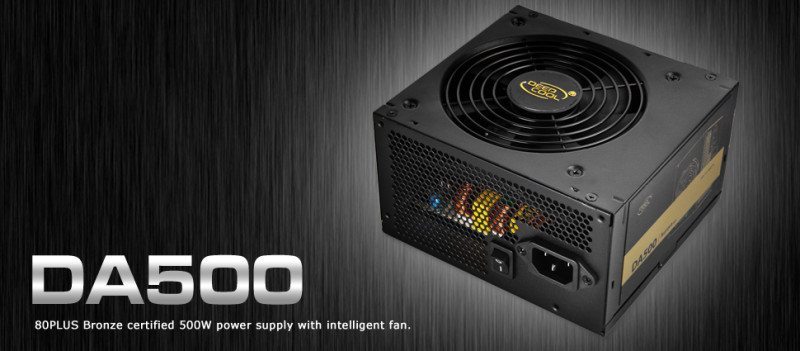
Deep Cool are one of the biggest names in the PC market, although perhaps not so much in Western markets, but that’s certainly something that has been changing. Deep Cool have launched a series of high-profile products over the last couple of years that you’ve no doubt seen. From their funky Steam Castle chassis to their Lucifer CPU coolers, there are a lot of nice products out there and that gives me high hopes for their new DA500 power supply.
“DA 500 is certified with 80 plus bronze with up to 85% electrical efficiency enabling lower heat generation and lower operation cost. Outstanding and stable performance makes it one of the ideal choices for multi-purpose usage. Double layer EMI filters protect from magnetic interference and restrains noise while operating.”
This unit is designed to be a little budget-friendly, so I’m not expecting earth-shattering performance, but I am expecting it to be a strong contender in its respective price bracket. Not everyone can afford nor requires high-end hardware, but the mid-budget market is fiercely competitive, so it’ll be fun to see how Deep Cool can compete.
- Compliant Intel ATX12V v 2.31
- The integrated Active PFC+ PWM Combo Controller will increase the efficiency of exchange and make PFC higher than 99%
- 80 PLUS® Bronze certified — up to 85% efficiency
- Assembled copper + AL heatsink make cooling more efficient
- 120mm silent fan with PWM function
- The longer cable design supports cable management perfectly
- Double-Layer EMI Filter protects from electromagnetic interference & restrains noise
- Intelligentized eco-friendly chipset, consume < 1W in its off-mode, compliant Erp standard
- CircuitShield™ —OVP, UVP, SCP, OPP
- Supports Multi-Way SLI / CrossFire + Multi-Core CPUs

The packaging is pretty standard, with a nice run down of the major features and spec right on the front. The most notable things here are the 80 Plus Bronze efficiency, 100,000h MTBF and that promising 3-year warranty.
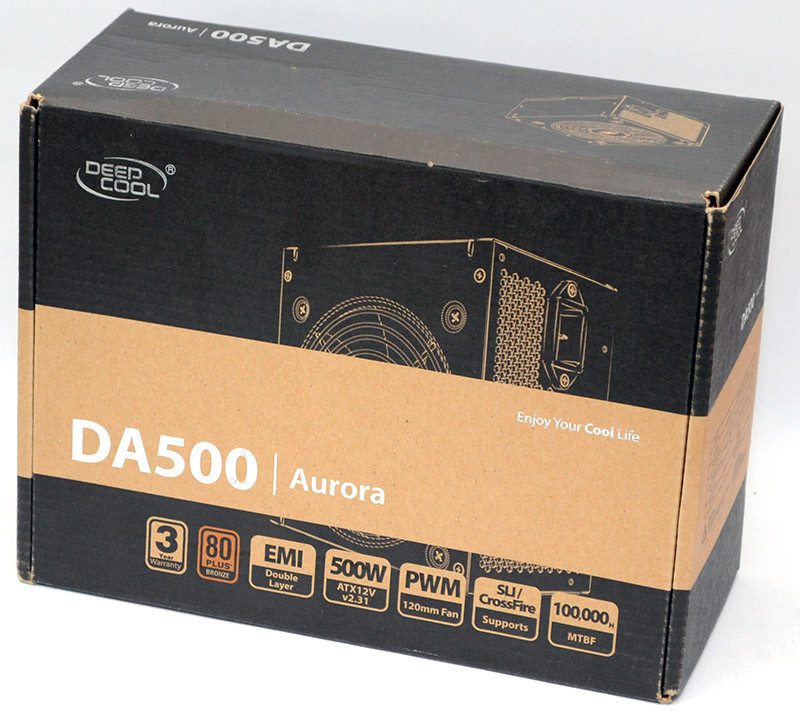
A Closer Look – Exterior
The DA500 is pretty reserved in terms of design, a fairly bland exterior and a fairly standard looking fan mesh. It’s got a nice light texture black finish, but that’s really about it, for those who can’t see the inside of their systems, this isn’t really an issue, but it clearly wasn’t designed for display rigs.
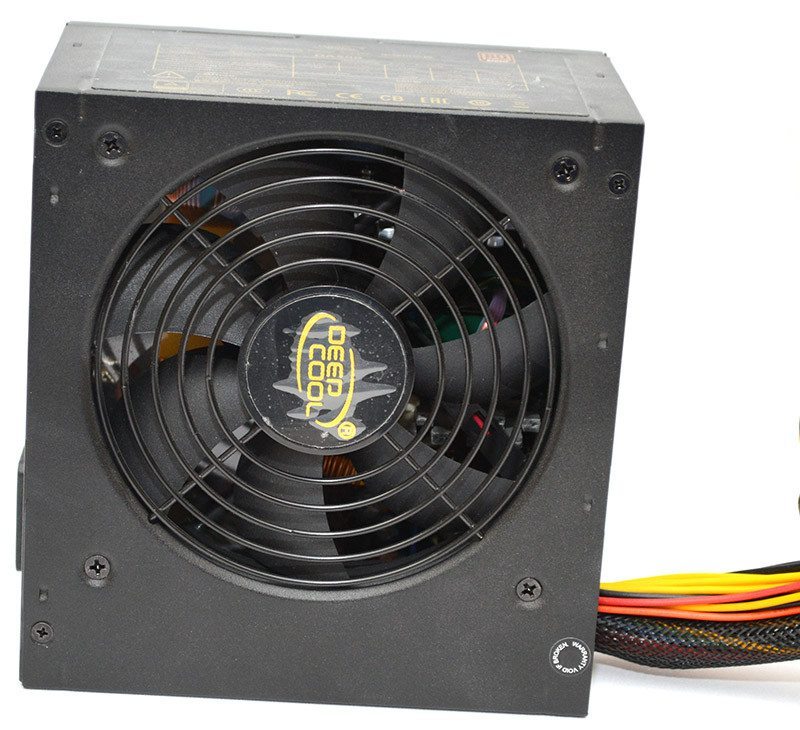
Down the side, you’ll find the main specification table, showing us a powerful +12v rail with up to 38A and 456W of power.
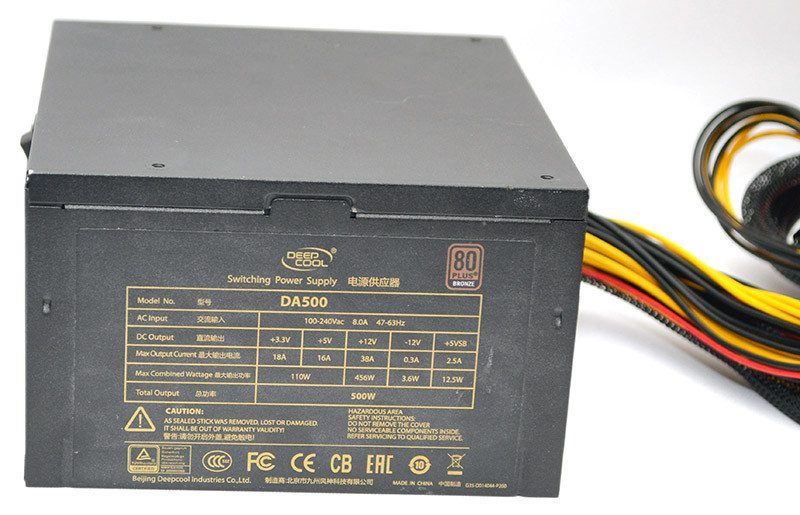
The top panel is just a blank panel, but it should blend in easily enough with your chassis.
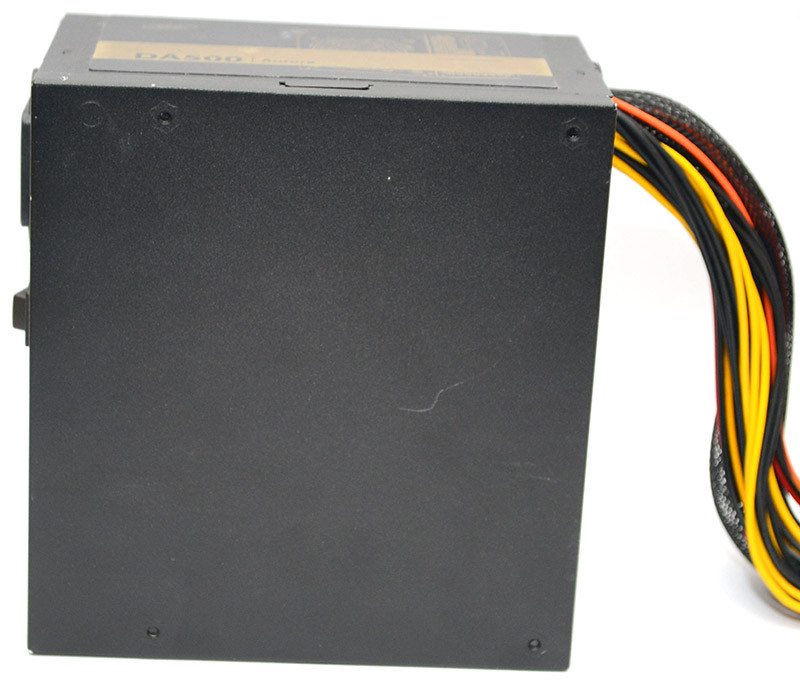
A simple branding sticker on the side, which strangely features a picture of the PSU on it; I can’t help but wonder if that PSU also has a picture of the PSU on it.
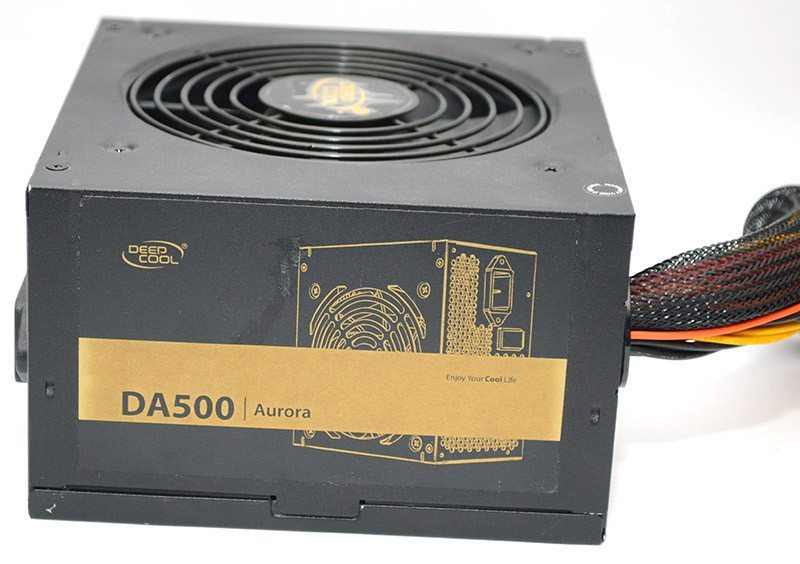
Plenty of ventilation around the back, although there is clearly room for even more below the AC socket. One thing I am happy to see is a master power switch, handy for shutting your system completely off.
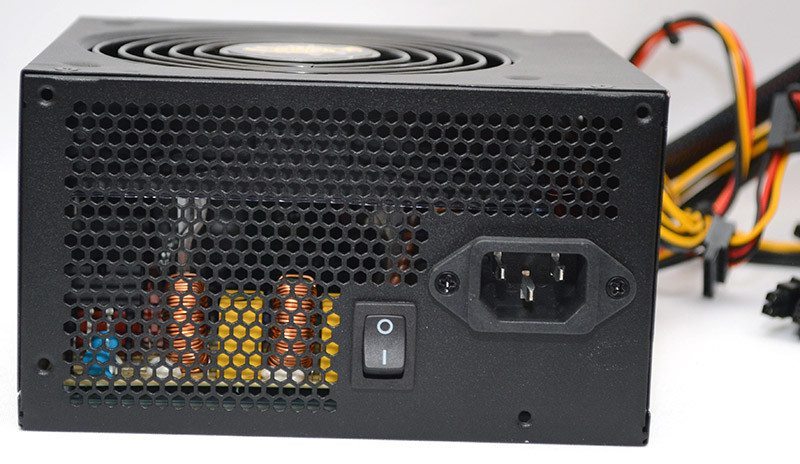
This is a non-modular PSU design, so all the cables pass through this single opening. There’s a plastic grommet around the opening to prevent the casing causing damage to any of the cables.
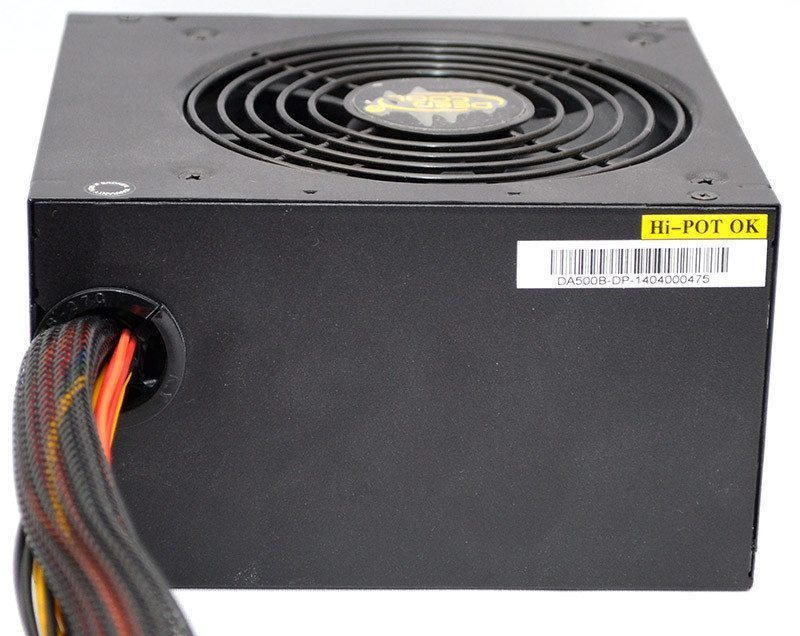
Cabling
The cables on this unit are anything but fancy, with bright colours and a rather thin braiding on the 24-pin cable. They feel fairly durable, but can be a little unwieldy as they’re a little longer than usual, although this is no bad thing if you’re fitting this unit in a larger chassis.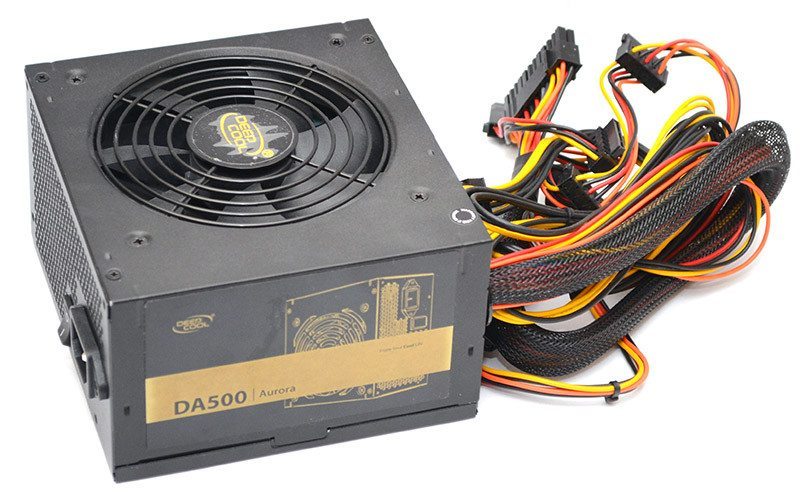
A Closer Look – Interior
On the interior, I’m quite surprised to see the PCB is significantly smaller than the PSU housing, especially for a unit that only uses a 120mm fan. Deep Cool could have used a larger fan or a smaller casing, either way, it seems like a waste of space here.
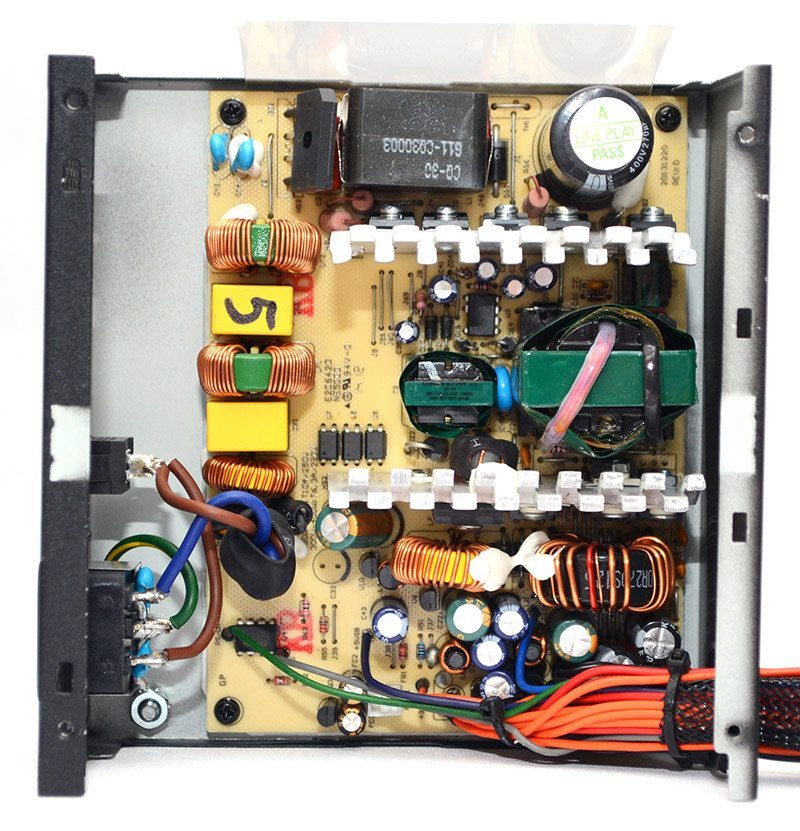
There’s a mixture of caps used in this unit, but it’s nice to see that despite being hard-wired, the interior is surprisingly clean and tidy, with a good amount of space between all vital hardware and there’s very little cable trailing through the interior, so airflow should be unhindered.
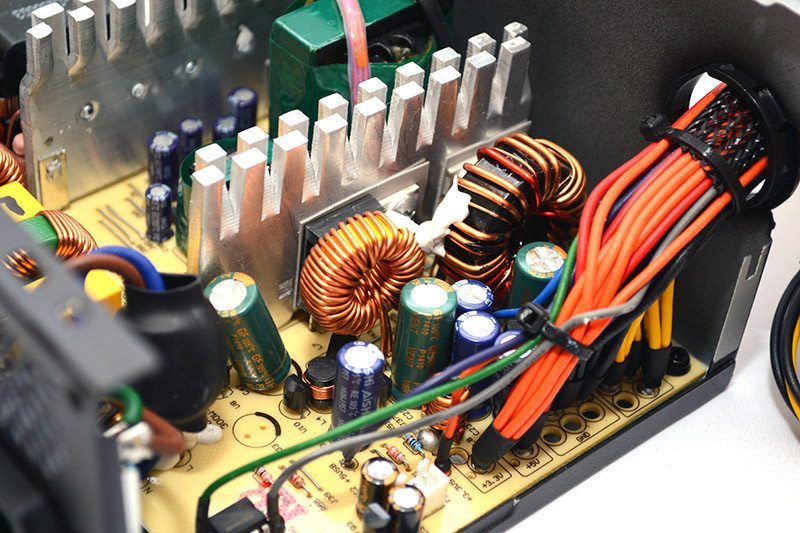
There are two small heat sinks on the interior, smaller that we usually see inside similar spec units, but again, there is a lot of open space here for airflow, so that shouldn’t be an issue.
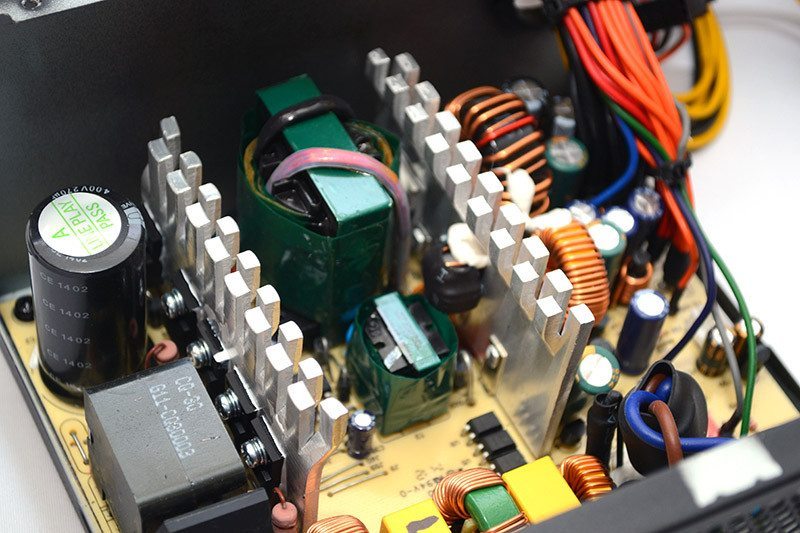
The main capacitor is a CE 1402 , which is rated for 400V at 270 uf.
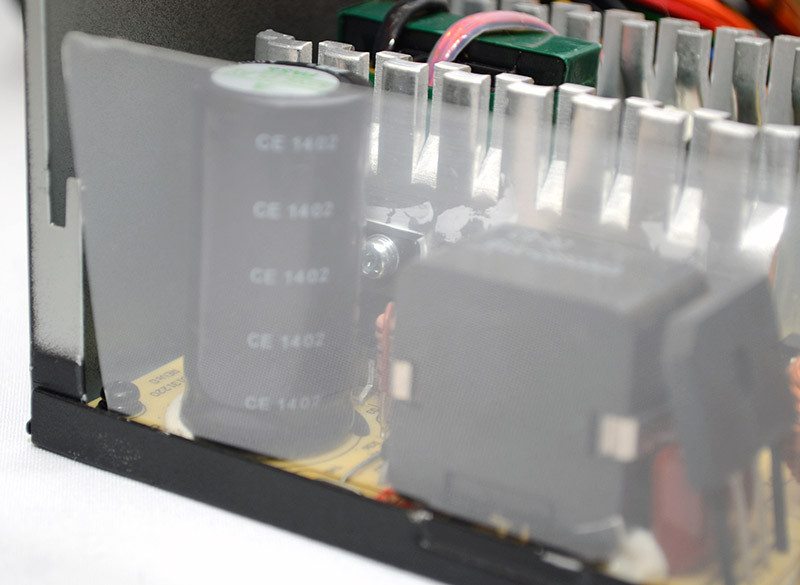
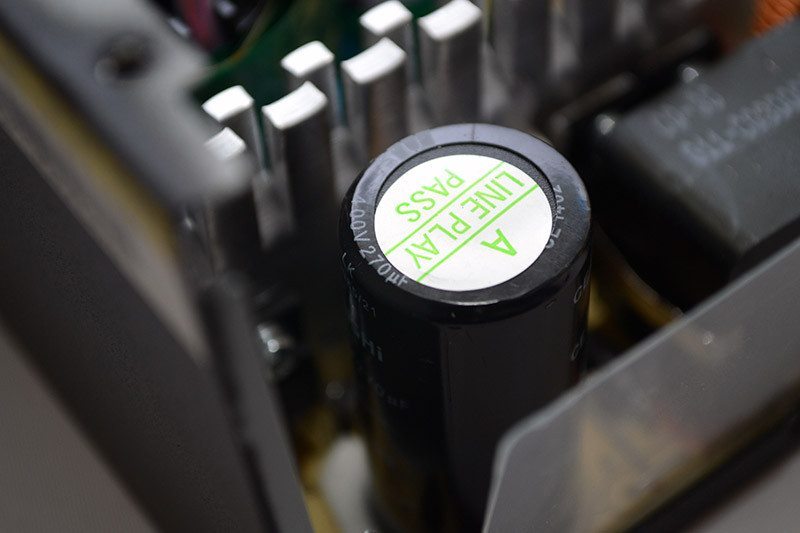
The AC and line-filtering stage is really neat and tidy, which is surprising as even on high-end units we see a lot of excess solder and cabling here. In fact, looking around the interior, all the soldering is very neat and tidy and most of the PCB connections are sleeved to keep them protected, which is a promising indication of good build quality.
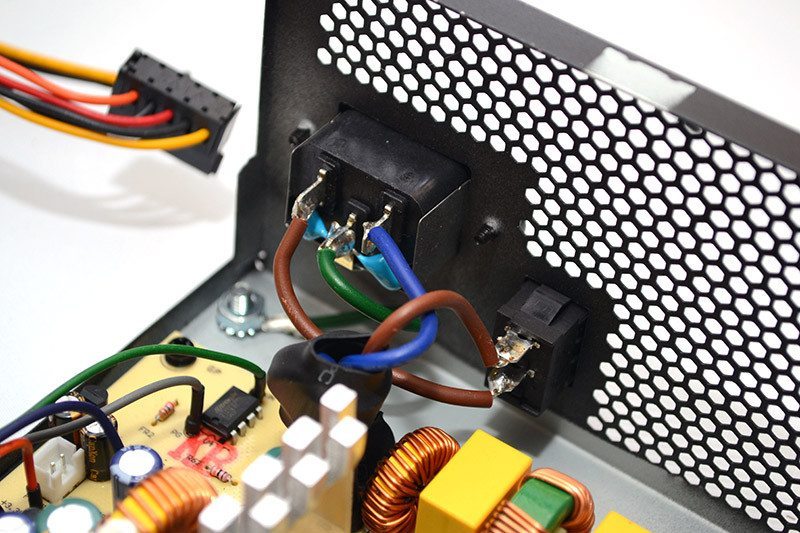
The fan is a 120mm Yate Loon sleeve bearing, rated for 33 dBA, 1650 RPM and 70.5 CFM, which is pretty decent and should give us good cooling and acoustic performance.
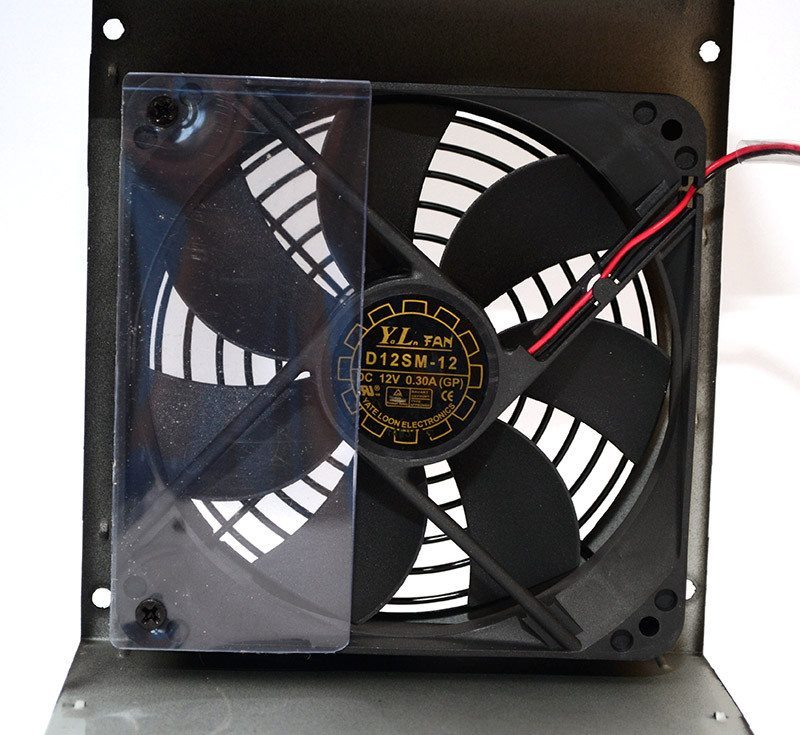
Test Procedure
At eTeknix we take the power supply testing procedure very seriously and have invested a lot of resources into acquiring the appropriate testing equipment. For all power supply reviews we test the power supplies with dedicated power supply testing equipment. This means we are able to get the most accurate results from our testing as opposed to using software benchmarks (such as OCCT) or multi-meter readouts which are broadly inaccurate.
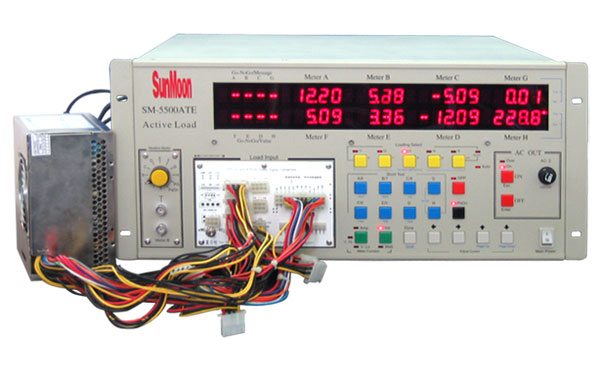
Our test machinery is as follows:
- Sunmoon SM-5500ATE Active Load Tester (1200W rated)
- Stingray DS1M12 USB Oscilloscope
- Voltcraft DT-10L laser tachometer
The eTeknix test procedure involves:
- Testing each power supply at 20/40/60/80/100% load (with balanced load across all rails) and measuring PFC (power factor correction), efficiency (actual power divided by power “pulled at the wall”) and voltage regulation (deviance from expected voltages of 3.3/5/12 on the main rails).
- Measuring ripple with an oscilloscope at 20/40/60/80/100% load.
- Measuring fan speed after a stabilisation period of five minutes at each load scenario using the Voltcraft DT-10L laser tachometer and a reflective strip on the fan.
- Testing each power supply’s OPP (Over Power Protection) mechanism and seeing how many watts each power supply can deliver before shutting down
Other things to consider are that
- We recognise that a single yellow 12 volt cable can provide only 6 Amps before overheating (which corrupts voltage regulation and efficiency) and so we used an adequate number of cables for each power supply to ensure there is not efficiency loss from poor cables selection
- Our Sunmoon SM-5500ATE power supply tester is not capable of testing more than 300W on each of the 12 volt rails so where a power supply provides more than 300W on a 12 volt rail that power is distributed over multiple 12 volt rails on the load tester. For example a power supply with one 12 volt rail supplying 750 watts would be spread equally over three 12 volt rails on the load tester, a power supply with two 450W 12v rails would be spread over four 12v rails on the load tester, two 225W 12v rails for each of the 12v rails on the unit.
- We use the same time scale and horizontal millivolt scale on our oscilloscope for all ripple tests, that is a 20ms T/DIV (horizontal) and a 0.02 V/DIV (vertical) meaning the scale is from -80mV to +80mV, ATX spec dictates that the 12v rail must fall within 150mv of ripple and the 3.3/5 within 50mv so that scale allows us to include both 150 and 50mV peaks. (Some older PSU reviews use different scales which were later ditched as the visual representation they give is inadequate, in these reviews written measurements are provided only).
- Deviance is the terminology used to represent the way voltages diverge from the expected values
Efficiency, PFC and Voltage Regulation
Voltage Regulation
To test voltage regulation we load the power supply to five different load scenarios that give an equal spread of load across every single rail. So that means 20% on all rails, 40% on all rails and so on. We then calculate the average deviance of each rail from its expected voltage.

Solid results here from this unit, with good voltage regulation on most of the rails. The 12V rails could be tighter, no doubt about that, but they’re still within a safe margin overall.
Power Efficiency
Power efficiency is measured by calculating actual supplied wattage divided by the wattage drawn at the wall/plug, multiplied by 100 to give a percentage. We then compare that to the particular 80 Plus certification the company claims to see if it meets that. You can see the 80 Plus certifications below, we always test 230v power supplies.
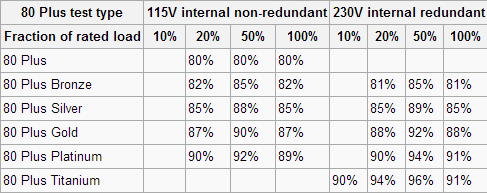
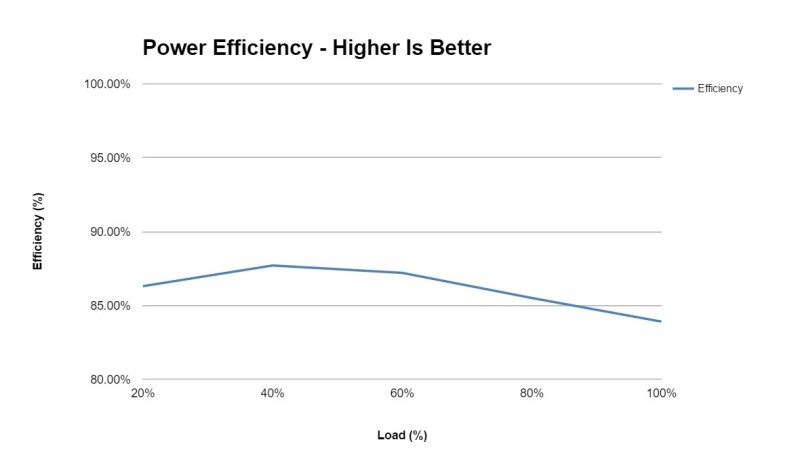
The unit falls within the Bronze classification quite nicely, nothing exceptional here, but at least you’re getting what you pay for.
Power Factor Correction
Power Factor Correction is the ratio of the real power flowing to the load, to the apparent power in the circuit. The aim of PFC is to make the load circuitry that is power factor corrected appear purely resistive (apparent power equal to real power). In this case, the voltage and current are in phase and the reactive power consumption is zero. The closer the number to one the better as this allows the most efficient delivery of electrical power (Source – Wikipedia).
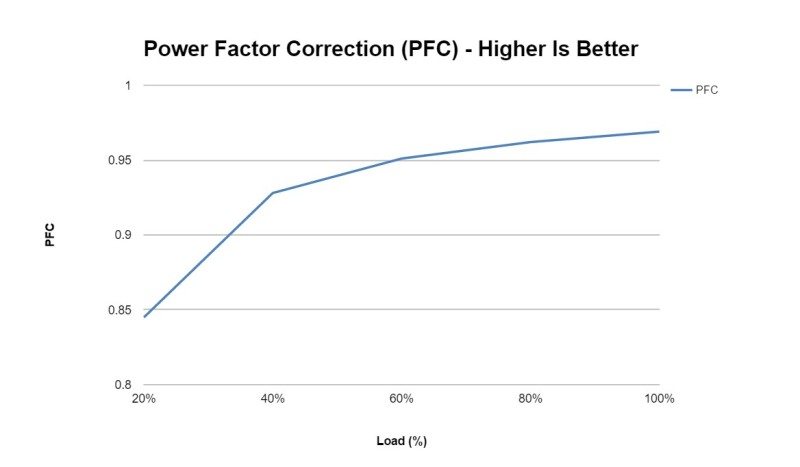
PFC is fairly standard here, nothing bad, but nothing amazing either, again just where I would expect it to be for a unit of this specification.
Ripple
Noise and Ripple can easily be measured by an oscilloscope. These show how much voltage fluctuation there is on a particular rail. We tested the rail stability of the 3.3 volt, 5 volt and 12 volt rails using an identical time and millivolt scale for all graphs. millivolt ripple is measured by the peak to peak size of the voltage curve.
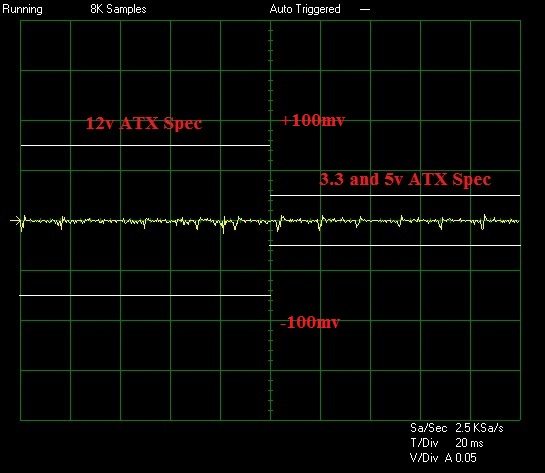
Sample Ripple Graph
The latest ATX 12 volt version 2.3 specifications state that ripple from peak to peak must be no higher than 50 millivolts for the 3.3 volt and 5 volt rails, while the 12 volt rail is allowed up to 120 millivolts peak to peak to stay within specifications. Millivolt figures are stated to the closest increment of 5 given their variability.
| Load (%) | 3.3V Ripple | 5V Ripple | 12V Ripple |
| 20 | 3.4 | 5 | 7 |
| 40 | 5.6 | 6.6 | 5.6 |
| 60 | 8.6 | 7.6 | 11.6 |
| 80 | 10 | 11.2 | 14.8 |
| 100 | 14.8 | 13.9 | 17.2 |
This is a stellar result, really impressive ripple suppression at all load scenarios and that’s always a nice thing to see.
3.3 volt @ 100%
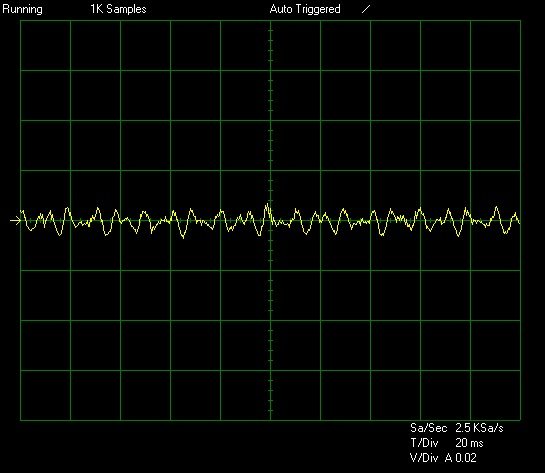
5 volt @ 100%
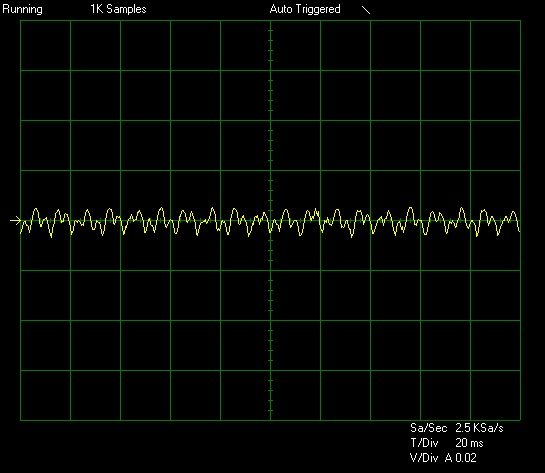
12 volt @ 100%
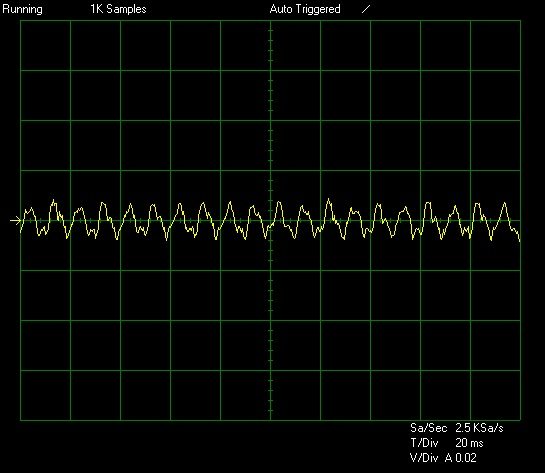
Over Power Protection and Max Wattage
Power supplies often quote as having various protection mechanisms such and the most important of these is Over Power Protection. In our testing we crank up the power draw until the power supply either shuts down (meaning the OPP mechanism is present and working) or blows up (meaning it is either not present or not working). We then note the maximum power consumption before the power supply shut down (or blew up).

Good performance here, with almost 40% over the 500W rating before the OPP kicked in and shut the unit off. Obviously, this means the OPP will kick in when you hit unsafe levels, but you’re going to have no issue with power spikes while gaming or running your system.
Fan Speed
When testing in a power supply laboratory it is difficult to take fan noise readings as the noise from the Sunmoon test equipment and air conditioning corrupts everything. The next best thing in our circumstances was reading off the fan speed with a tachometer to get an idea for the noise. The ambient temperature during testing held constant at 22 degrees, with 1 degree of variation. Each power supply had a consistent time period of 5 minutes to stabilise between each load scenario.
In my experience the following general relationships apply between noise levels and fan speeds, though it can vary greatly between the type of fan used.
- Below 800 RPM – Inaudible/Silent
- 800 to 1000 RPM – Barely audible
- 1000 – 1200 RPM – Audible but still quiet
- 1200 – 1400 RPM – Moderately noisy
- 1400 – 1800 RPM – Noisy
- 1800 RPM or higher – Intolerable
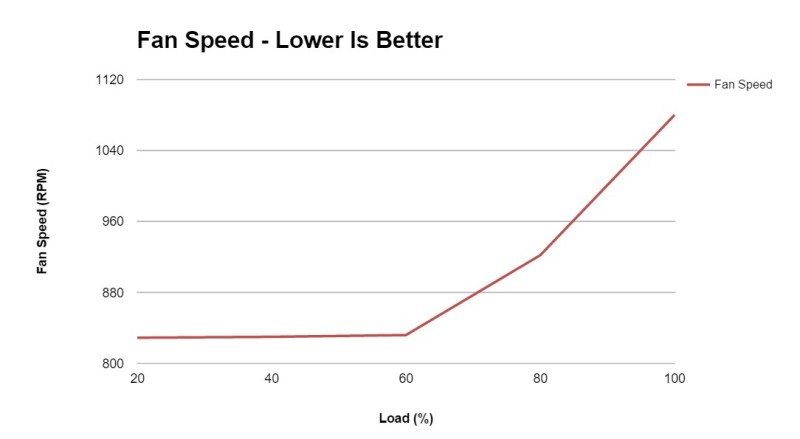
Great performance again, with virtual silent fan performance up to 60% load and even at 100% there was still only a little air turbulence to be heard and you’re unlikely to hear this once it’s installed in a chassis.
Final Thoughts
Pricing
I can’t find stock of this anywhere, which is not a good sign and hopefully you’ll have better luck at your own retailer of choice. If this information becomes available, I will update this section as soon as possible.
Conclusion
This unit is nothing particularly exciting, but at the right price, it has got potential to be a good budget unit for low to mid range system builds. The voltage regulation is ok, but could be better on the 12v rails, although it’s certainly where I would it expect for a PSU of this specification. What did impress me was the ripple suppression, easily on par with much more expensive units and that’s certainly a positive aspect of this unit.
The build quality doesn’t look anything special on the exterior, it’s a fairly standard looking unit and the non-modular design doesn’t scream great quality, but it’s really just an aesthetics thing more than anything. The interior of the unit, however, is very well made, with a well spaced out PCB, good cooling and immaculate soldering, all of which no doubt contributed to the low ripple in our testing.
Unfortunately, there’s little else to say about this unit, especially with the limited availability, if I could find this unit in the UK for around £40, it could be a strong contender for the budget market as the performance is as good as leading brands in this area.
Pros
- Excellent ripple suppression
- Very tidy interior build quality
- Quiet
Cons
- Poor availability
- 12v rail performance could be better
- Unit is larger than it needs to be
“A good budget power supply with clean power delivery, hindered by limited availability. If Deep Cool can get this unit into a slightly smaller form factor, get the stock into stores and tighten up that 12v rail, this could be a fantastic unit for budget system builds.”
Thank you Deep Cool for providing this review sample.



















